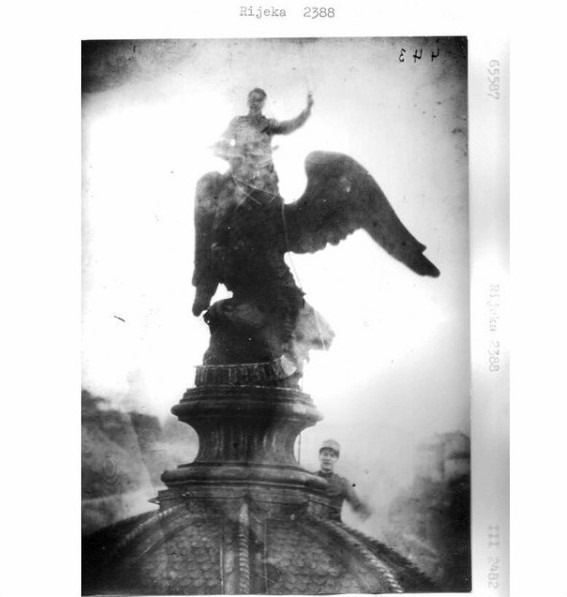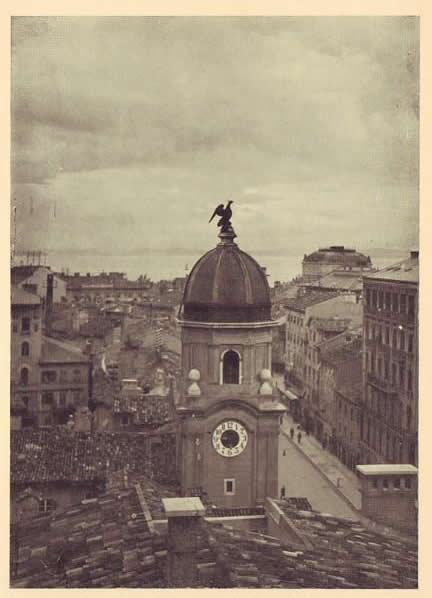The history of Rijeka’s two-headed eagle begins in the 17th century when, at the request of the people of Rijeka, on 06 June 1659 emperor Leopold I issued a charter with which he approved a coat of arms for Rijeka. According to this charter, the coat of arms was described as follows: above the Damascus blue background with gold borders, there is a shield with a crimson red background at the centre of which there is a two-headed eagle standing on a rock with its right claw, and with its left claw holding a jug from which water is pouring out. Above the eagle there is a crown, and below it the inscription Indeficienter.
The first eagle sculpture atop the City Tower was probably installed in 1754, and its author was Lodovico Ruppani, a tinker from Rijeka. This one-headed eagle made of tin was removed in 1890 by the decision of the City Council, and was transferred to the city museum as a souvenir (its fate after this point remains unknown; however, it is likely that it was recast for military purposes, as was often the case with many metal objects).
How fond the people of Rijeka were about the coat of arms of their city was evidenced by the multiple protests that ensued after the two-headed eagle was removed from the top of the City Tower in 1890 due to reconstruction, which was documented even by several folk songs, such as the popular ?Indeficienter?.
At the same time, a political dispute arose between the Hungarian and city authorities regarding whose flag should be flown on the town clock – the Hungarian flag or the flag of Rijeka.
 The second sculpture was installed on 01 July 1906 and was accompanied by a huge celebration. The initiative for the return of the city’s eagle to the cupola was started by the Committee of the Women of Rijeka, which also collected the funds for this endeavour. The wooden model was created by the sculptor Vittorio De Marco, of whom very little is known, and it was cast in an alloy of aluminium and zinc in Matteo Skull’s foundry. The sculpture was 200 cm tall with a wingspan of 300 cm, and weighed 2000 kg together with its plinth. The inauguration ceremony for the new two-headed eagle on the City Tower was held on St Vitus Day, 15 June 1906. It is said that almost the entire city witnessed this event, and song was heard late into the night.
The second sculpture was installed on 01 July 1906 and was accompanied by a huge celebration. The initiative for the return of the city’s eagle to the cupola was started by the Committee of the Women of Rijeka, which also collected the funds for this endeavour. The wooden model was created by the sculptor Vittorio De Marco, of whom very little is known, and it was cast in an alloy of aluminium and zinc in Matteo Skull’s foundry. The sculpture was 200 cm tall with a wingspan of 300 cm, and weighed 2000 kg together with its plinth. The inauguration ceremony for the new two-headed eagle on the City Tower was held on St Vitus Day, 15 June 1906. It is said that almost the entire city witnessed this event, and song was heard late into the night.
The eagle survived in its initial form up to 1919 and the arrival of D’Annunzio to the city, when one of D’Annunzio’s arditi cut one of the eagle’s heads off. This was because the Italian fascists held the two-headed eagle to be Austrian, and the one-headed eagle to be Roman. The sculpture remained atop the city cupola in this form all the way up to 1949, when it was removed.
 Nevertheless, the eagle managed to survive in this truncated form all the way up to 1949, when the communist authorities of the day marked it as a bourgeois and anti-socialist symbol and, on 20 January 1949, had it removed and broken into pieces. However, they were not completely successful in their aim as the people of Rijeka, who were among the workers of the shipyard ?3. Maj? who were ordered to remove the eagle, managed to hide several pieces of this bronze sculpture and preserve it to this very day at several locations in the city.
Nevertheless, the eagle managed to survive in this truncated form all the way up to 1949, when the communist authorities of the day marked it as a bourgeois and anti-socialist symbol and, on 20 January 1949, had it removed and broken into pieces. However, they were not completely successful in their aim as the people of Rijeka, who were among the workers of the shipyard ?3. Maj? who were ordered to remove the eagle, managed to hide several pieces of this bronze sculpture and preserve it to this very day at several locations in the city.
At the initiative of the association ?Free State of Rijeka? (Slobodna Država Rijeka), the sculpture of the two-headed eagle is planned to be soon returned to the town clock, while the City Tower itself was renovated for the purpose of installing the statue on it once again.
Many hold that this act will contribute to strengthening the identity of the people of Rijeka, though the extent to which it will accomplish this is unclear as Rijeka’s identity is constantly changing.
For the purpose of returning the historical sculpture of Rijeka’s two-headed eagle to the top of the cupola of the City Tower, there are plans to initiate a programme that includes the formation and casting of a full-size sculpture (based on an existing small-scale model) and the preparatory works for its installation in situ during 2016.
 The Department for Culture of the City of Rijeka initiated this project in late 2009, when it requested the first opinion of the authorised conservation department on this programme. From this moment onwards, the project unfolded according to their guidelines. In 2010, an opinion on the stability of the construction of the cupola was drafted, which confirmed that it was possible to reinstall the sculpture on its top. In 2011, the creation of a historical and artistic study existing archival materials and on the sculpture itself was continued. This was necessary as, up to that point, concrete knowledge on the sculpture had been scant. The study showed that no remains of the sculpture existed (whether of the first one from the 18th century or the second from the early 20th century), and neither did any models of them – however, archival sources and photographs were found.
The Department for Culture of the City of Rijeka initiated this project in late 2009, when it requested the first opinion of the authorised conservation department on this programme. From this moment onwards, the project unfolded according to their guidelines. In 2010, an opinion on the stability of the construction of the cupola was drafted, which confirmed that it was possible to reinstall the sculpture on its top. In 2011, the creation of a historical and artistic study existing archival materials and on the sculpture itself was continued. This was necessary as, up to that point, concrete knowledge on the sculpture had been scant. The study showed that no remains of the sculpture existed (whether of the first one from the 18th century or the second from the early 20th century), and neither did any models of them – however, archival sources and photographs were found.
Based on the aforementioned, in 2013 the Academy of Applied Arts (associate prof. Hrvoje Urumovi?) created a small-scale model of the sculpture from 1906, which will be used to create the full-size sculpture. The model was created according to the guidelines of the Conservation Department in Rijeka, according to which the final sculpture ought to be a facsimile to the greatest extent possible.
Sources: Cronologia - Istriana - dal 1941 al 1999; Wikipedia; rijeka.hr


